Guaranteed Free Delivery by 12/24! available on most items - Details

How to Install Rough Country 1.25 In. Body Lift on your 1987-1995 Wrangler
Tools Required
- Floor Jack
- Jack Stands
- 3/8" Socket / Wrench
- 1/2" Socket / Wrench
- 5/8" Socket / Wrench
- 13mm Socket / Wrench
- 19mm Socket / Wrench
- Drill Motor
- 1/4" Drill Bit

Shop Parts in this Guide
IMPORTANT PRE—INSTALLATION INSTRUCTIONS
Prior to beginning this installation it is always good to use a penetrating oil and spray all body mount hardware that will be removed. Typically the stock body bushings will need to be checked to ensure they are in good condition. If the stock body bushings are cracked or deteriorated they must be replaced. This should be performed as the body lift is installed. Failure to perform this maintenance could jeopardize the operating safety of the vehicle.
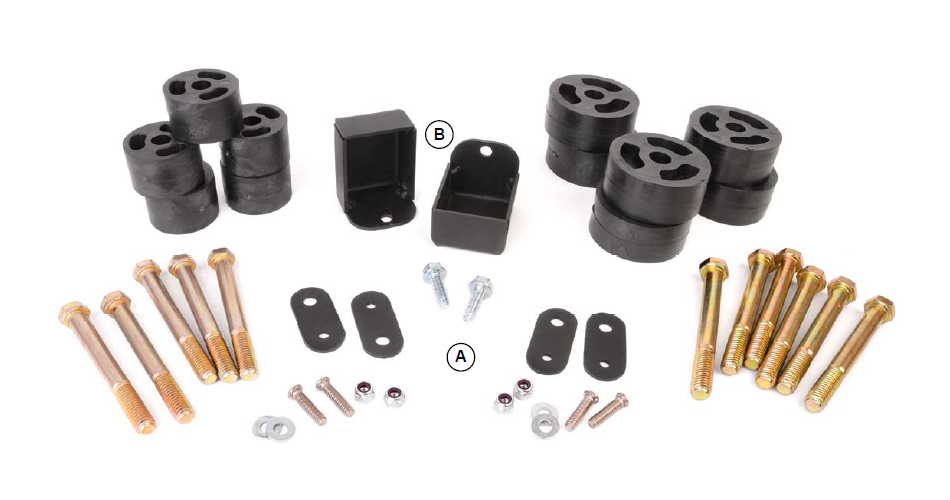

INSTALLATION INSTRUCTIONS
1. Disconnect the negative battery cable using 1/2” wrench.
2. Remove the plastic jeep cover from front of vehicle using a 3/8” wrench and the metal plate that secure the brake line.
3. Disconnect air intake from air filter housing and from throttle body. Depending on year remove coolant reservoir and power steering reservoir from fan shroud.
4. Remove the 4 bolts from radiator shroud using a 13mm socket. See Photo 1.
5. Loosen all eleven body mount bolts using 5/8” socket. There is one in center of grill, three under each door, two above rear axle and two at each rear corner. See Photo 2.
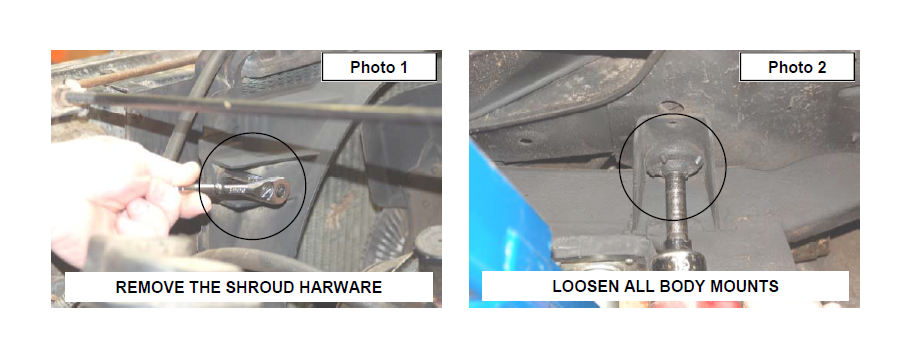
6. Only remove bolts on one side at a time. Front center bolt must be remove for both sides. See Photo 3.
7. Using floor jack or jack stand and a wood block raise body from frame only enough to safely install the body puck. Take Caution not to over extend wires, brake lines, cables and steering shaft.
8. The 1 1/4” tall x 3” diameter body pucks install on the three body mounts under doors. See Photo 4. Secure using the supplied 1/2” x 4 1/2” bolts.
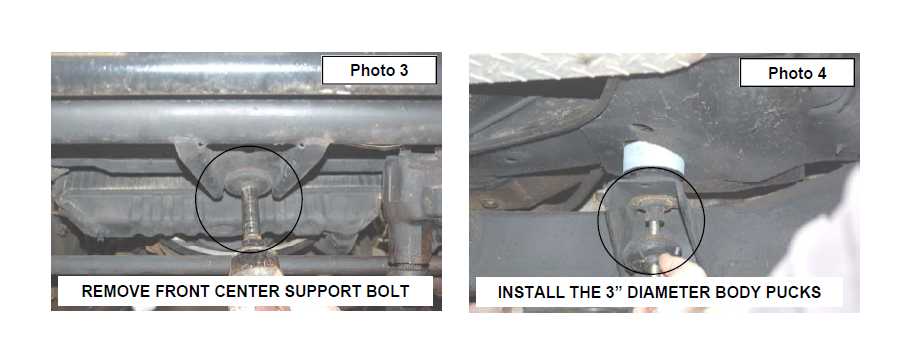
9. The smaller 1 1/4” tall x 2” diameter pucks will install the remaining five body mounts. Use the supplied 7/16” x 4” bolts. See Photo 5.
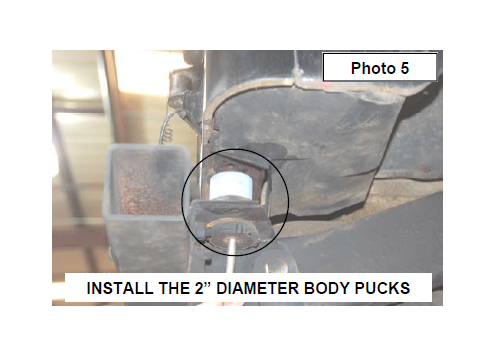
10. Install the new front bump stop extension under the bump stop on radiator core support. Using the bracket as a template mark hole to be drilled. See Photo 6.
11. Drill a 1/4” hole in frame and secure using the supplied 5/16” x 1” self tapping bolt and a 13mm socket to tighten. See Photo 7. Do not over tighten the bolt. Repeat for the opposite side.
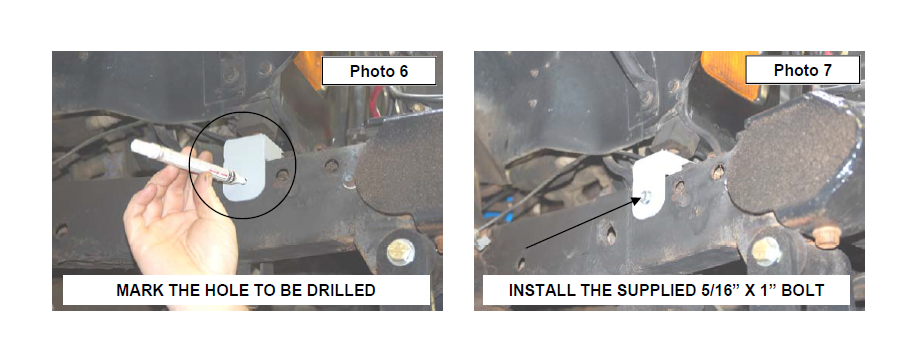
12. After all body puck are in tighten all bolts. 19mm socket for the 1/2” bolts and 16mm for the 7/16” bolts.
13. Install the 1/4” clinch studs into radiator drop bracket using hammer and small socket.
14. Install the four radiator fan shroud drop brackets using stock hardware. See Photo 8.
15. Reinstall the shroud on the bracket with the supplied 1/4” lock nuts and flat washers. See Photo 9.
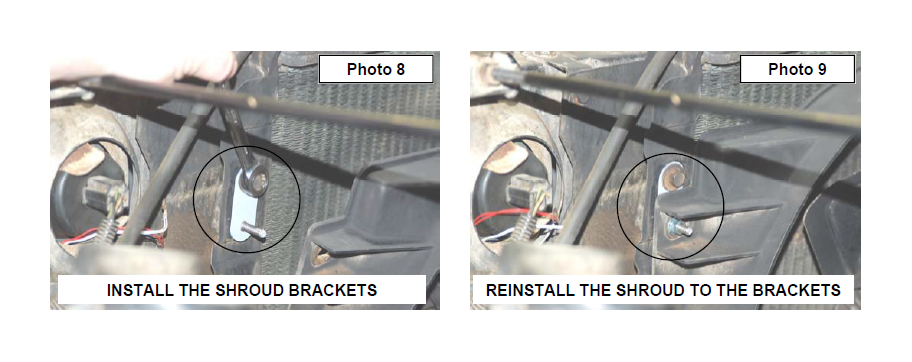
16. Reinstall the coolant reservoir and power steering reservoir to the fan shroud if applicable. Use a 13mm for stock bolts and 7/16” for new nuts.
17. Reconnect the air intake to the air filter housing and throttle body.
18. Reinstall plastic jeep cover and metal plate using 3/8” socket. Metal plate should go under the body mount. Install hard brake line back into clips.
19. Re-Check all fastener to confirm all components are not binding or in the way of moving parts.
POST INSTALLATION INSTRUCTIONS
1. Check all fasteners for proper torque. Check to ensure there is adequate clearance between all rotating, mobile, fixed and heated members. Check steering gear for interference and proper working order. Test brakes.
2. Check to ensure metal brake lines have sufficient slack to eliminate interference and maintain proper working order. Failure to perform inspections may result in component failure.
3. Readjust headlights to proper settings.
MAINTENANCE INFORMATION
It is the buyers ultimate responsibility to have all bolts/nuts checked for tightness after the first 100 miles and then every 1000 miles. A qualified professional mechanic must inspect wheel alignment steering system, suspension and driveline systems at least every 3000 miles.


